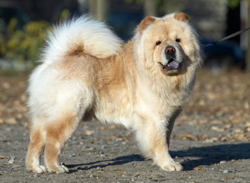The Chow Chow is a medium-sized, muscular, powerful, and sturdy dog breed with a spitz appearance. The Chow's coat comes in five colors, including black, red, blue, cinnamon, and cream, and it can be either rough or smooth. The rough variety has a dense, straight, coarse, and offstanding outer coat, and a wooly and soft undercoat. The smooth variety has a hard, dense, and smooth outer coat with no obvious ruff or feathering. Chow Chows are known for their blue-black tongues, compact bodies, large heads, and bushy tail that curls tightly over their backs. They have a scowling expression and dark, almond-shaped eyes. The breed measures 17 to 20 inches tall at the shoulder and weighs 40 to 70 pounds.
The breed has a strong pack mentality that can cause problems if not dealt with during training.
These dogs are affectionate and devoted, but they are not especially lovey or cuddly. This may disappoint some people, especially children. Because they are not very active dogs, they are suitable for living just about anywhere, including in urban settings.
The Chow Chow's most distinctive physical trait is its blue-black tongue. However, Chow puppies are born with pink tongues. Their tongue color gradually darkens over 8 to 10 weeks.
Chows have cat-like personalities and they are known for being independent and stubborn. They usually get along well with other household pets. They tend to be serious and protective, and they are rarely physically affectionate. However, they are very devoted to their family and are discerning and reserved with unfamiliar people.
Chow Chows need daily exercise, but it should not be strenuous activity. Also, these dogs do not do well in humid weather, and this should be a consideration during the summer months. Casual strolls or free playtime is usually sufficient for these dogs.
Visitors to the Chow Chow's house need to be warned not to approach these dogs uninvited or pet them. While these dogs are not mean-spirited, they are wary of strangers. It is also important to approach these dogs from the front due to their poor peripheral vision.
Chow Chows are a fairly healthy breed, but they do suffer from a number of health conditions that are less common in some other breeds. These dogs are prone to congenital hip dysplasia, entropion, elbow dysplasia, cataracts, distichiasis, and persistent pupillary membranes. Additionally, the breed is known to be affected by gastric torsion, stenotic nares, patellar luxation, and an elongated palate.
Chows are also affected by renal cortical hypoplasia, a hereditary condition in which the cortex of the kidneys develops incompletely. Hypothyroidism also affects Chow Chows, as does pemphigus foliaceous, which is an autoimmune skin disease, and melanoma, a potentially fatal type of skin cancer.
Routine care by a veterinarian, combined with good nutrition and regular exercise, help ensure Chow Chows live 12 years or even longer.
Chows are less eager to please than other breeds, and they can be very independent and stubborn. These traits can make training difficult. These dogs tend to behave exactly as they want and do exactly as they wish. These behaviors cannot be tolerated, though, if a peaceful working relationship with the Chow is to be established.
The breed has a strong pack mentality that can cause problems if not dealt with during training. Training and socialization should begin early and continue throughout life for the most success. Puppy kindergarten may help in some cases, and exposing puppies to a variety of sights, sounds, and people will go a long way toward preventing suspicious behavior in this breed. These dogs do not respond well to harsh training methods or punishment.
Chow Chows are very intelligent and can be taught tricks. With sufficient training, they make good companions for older children and families. Anyone who purchases or adopts a Chow must be willing and able to devote a lot of time and attention to training and socialization.
It's important to groom and bathe Chow Chows regularly to maintain the health and appearance of their double coat. Smooth-coated dogs need brushing once weekly, while rough-coated dogs need brushing at least every other day. Brushing should increase to daily during the fall and spring shedding seasons. Both coat varieties are prone to heavy shedding.
Chows benefit from, and sometimes enjoy, a warm bath. Shampooing should be done with a gentle, pH-balanced canine shampoo, and the coat must be blown dry. Bathing and blow-drying helps remove loose hair to keep it off furniture and clothing.
The ears need cleaning once weekly, and they should be checked regularly for redness, odor, and other signs of infection. Brushing the teeth as often as possible, and using dental treats and water additives, will help ensure fresh breath, strong teeth, and healthy gums. The nails need clipping about once each month.
The Chow Chow is an ancient breed of northern China. Their true origin is unknown, but the dogs appear in sculpture and pottery dating back to the Chinese Han Dynasty (206 B.C. to 22 A.D.). There is speculation that the Chow Chow was the original ancestor of the Samoyed, Pomeranian, Norwegian Elkhound, and Keeshond breeds.
These dogs were all-purpose dogs, working mainly in hunting, pulling, herding, and protection. When the imperial hunts ended in China, the breed's numbers declined significantly. However, a few pure Chow Chows were kept in wealthy households and monasteries, and these stores kept the breed alive.
The breed was imported to England, and then to America, during the late 1800s. Today, the Chow is primarily a companion animal and is also seen in show rings.
The American Kennel Club officially recognized the Chow Chow in 1903.

